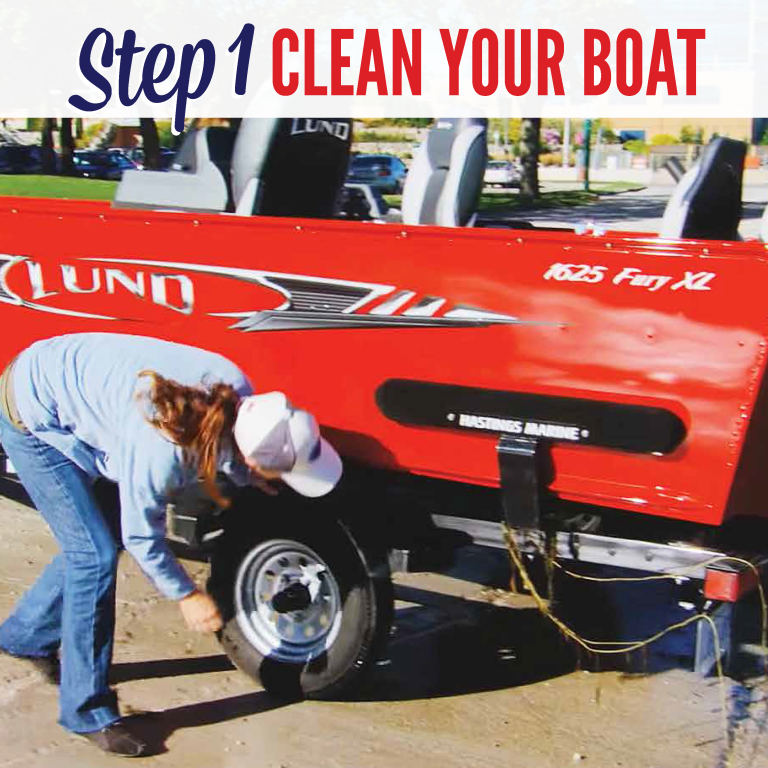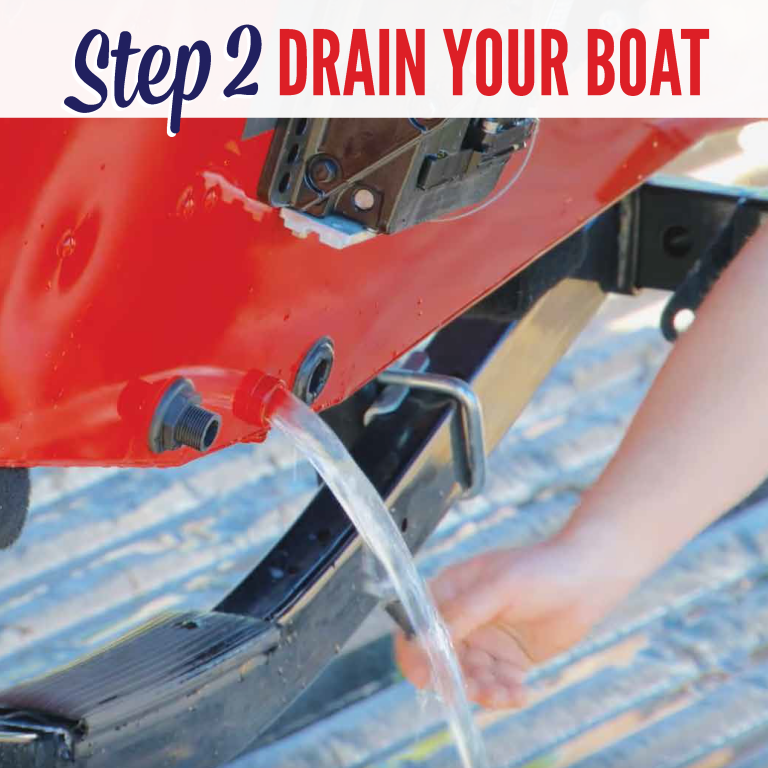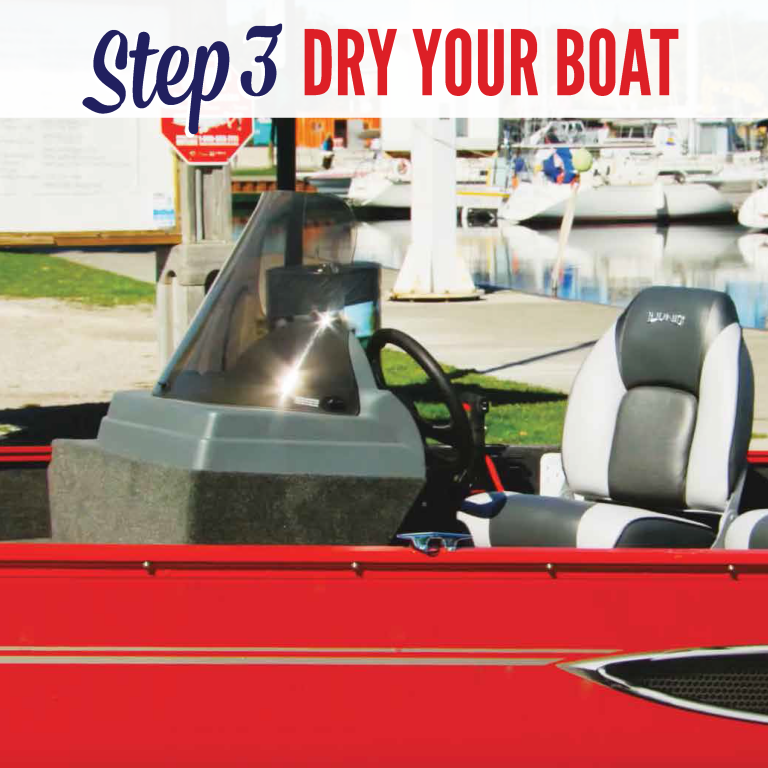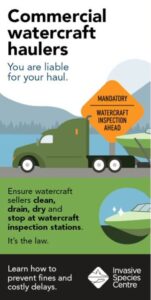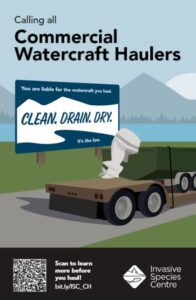Stop the Spread of Aquatic Invasive Species
Attention commercial haulers! Did you know that you could be shipping more than just boats? You might have an aquatic hitchhiker on board! For example, Zebra and Quagga mussels are tiny invaders that have the potential to cause huge economic and ecological harm. They can spread by attaching to boats as adults or by hiding in compartments as veligers (microscopic larval stage). Do your part to protect Canada’s waters and learn about the rules and regulations.
Most provinces require watercraft and hauling gear to be clear of aquatic invasive species when transporting. Commercial haulers are responsible for meeting legal requirements of hauled watercraft, even if they don’t own the watercraft. Make sure to look at regulations for provinces you are travelling from, to and through in order to make sure you follow requirements when preparing your haul.
On this page:
Know Before You Go!
The commercial hauler is responsible to ensure that the watercraft they are hauling meet provincial requirements. The hauler is in violation when transporting watercraft with AIS. It is your responsibility to know the rules and regulations in the province you are hauling through. Canada’s western provinces are working hard to stop the spread of invasive mussels and you can be fined for not complying with these laws. Here’s what you need to know before you go!
- There are mandatory boat inspection stations in Manitoba, Saskatchewan, Alberta and British Columbia. Failure to stop at these inspection stations when they are open can result in fines in each province. Did you know that detection dogs also joined the search for invasive mussels at inspection stations in some provinces?
- Pull your drain plug! It is the law to have your drain plug removed when moving a watercraft over land in Manitoba, Alberta and Saskatchewan. Failure to do so can result in fines in each province.
- Travelling to B.C.? Anyone transporting a watercraft into the province is required to contact the Provincial Program before launching a boat in B.C. waters. Travelers must wait for instruction from an inspector before launching.
- Under federal, as well as provincial legislation in Manitoba, Saskatchewan, Alberta and British Columbia, it is illegal to possess, transport and/or release Zebra and Quagga Mussels dead or alive.
Western Canada have had many new and used boats come through with standing water (from testing), which poses a large risk of transporting microscopic aquatic invasive species, many of which can survive great lengths of time. If boats are not able to be safely and effectively inspected on site, a follow up will be required. For example, if boats are shrink-wrapped when they arrive at the scale, the wrap may need to be removed enough to conduct the inspection on site. If this cannot be conducted, a Quarantine Order will be issued until a time that the wrap can be removed and properly inspected.
Quarantine Orders prohibit the following until it has been lifted; launching the watercraft, draining water, washing the watercraft (internal or external), or altering the watercraft, including the addition of any fluids, that the inspector issuing the quarantine order did not see.
Many new boats are tested prior to shipment in high risk areas (e.g. lakes and reservoirs outside of Western Provinces). Western Canada is trying to work with watercraft manufactures, commercial haulers, and the boat shops that are receiving the boats to ensure that there are no aquatic invasive species risk and that the process is as efficient and effective as possible.
Commercial Haulers Resources:
Rules, Regulations and Contact Information
Always call the watercraft inspection contact of your destination jurisdiction to minimize delays and ensure legal compliance.
Make sure you review the legislation in the jurisdiction you’re travelling to for specific requirements.
Ontario introduced new legislation in January 2022 to update the Invasive Species Act. This was done in an effort to reduce risks of spreading aquatic invasive species. Aquatic invasive species in Ontario are addressed under the Invasive species Act.
These updates requires all water users in Ontario to properly clean watercraft, watercraft equipment, and any vehicle or trailer before placing them in the water. In Ontario, it is illegal to import, possess, or transport prohibited species. Failure to do so may result in fines.
Additional Resources:
Aquatic invasive species in Manitoba are addressed under the Aquatic Invasive Species Regulations of The Water Protection Act.
This legislation prohibits the importation, possession, transportation, and release of aquatic invasive species in Manitoba. It requires all water users in Manitoba to properly clean watercrafts, water related equipment, motor vehicles, and aircrafts before placing them in the water and upon removal from the water body (before transporting away from shore). There are also 6 control zones under the regulations which include areas where there are known aquatic invasive species and are used to prescribe additional requirements or restrictions to prevent further spread. These control zones require more stringent decontamination measures before they can be placed in another water body.
Contact Information:
Manitoba Inspection Station: (877) 867-2470
Additional Resources:
Aquatic invasive species in Saskatchewan are addressed in the Fisheries Amendment Regulations, 2020 under the Fisheries (Saskatchewan) Act. Under these regulations it is illegal to import, possess, or transport high-risk aquatic invasive species and it is illegal to use live fish or crayfish (dead or alive) as bait. The regulations allow conservation officers to inspect, quarantine, and decontaminate watercrafts that are known or suspected to contain invasive species. Aquatic invasive species identified as a high-risk threat by the Saskatchewan Ministry of Environment are added to a list of prohibited species under these regulations. It is illegal to import, possess, or transport prohibited species.
By law, watercraft users in Saskatchewan are required to:
- Drain your watercraft. Drain plugs must be pulled and watercrafts drained of standing water. It is illegal to transport your watercraft with a drain plug in place.
- Stop at watercraft inspection stations. If you are transporting a watercraft or water related equipment you are required by law to stop in at watercraft inspection stations.
Contact Information:
Saskatchewan Inspection Station: (800) 667-7561
Additional Resources:
Aquatic invasive species in Alberta are addressed under the Fisheries (Alberta) Act.
. It prohibits the possession and importation of aquatic invasive species and prohibits the entrance of invasive species to water bodies of any kind.
This act also describes the mandatory watercraft inspection stations, as well as powers to inspect, quarantine, and decontaminate watercrafts (new or used) that are known or suspected to contain aquatic invasive species.
By law, watercraft users in Alberta are required to:
- Drain your watercraft. Drain plugs must be pulled and watercrafts drained of standing water. Transporting your watercraft with a drain plug in place is illegal and can result in a $180 fine.
- Stop at watercraft inspection stations. When highway signage indicates that watercraft inspection stations are open, watercraft users are required to report in. Failing to stop at an open inspection station while transporting a watercraft can result in a $324 fine.
Contact Information:
Alberta Inspection Station: (855) 336-BOAT
Additional Resources:
Aquatic invasive species in British Columbia (B.C.) are addressed under the Controlled Alien Species Regulation. Under provincial legislation, anyone transporting a watercraft in B.C. is required to stop and report to all invasive mussel watercraft inspection stations. Failure to stop at an open inspection station could result in a $345 fine.
B.C. has a program in place for anyone bringing a boat into B.C. from out of province. Anyone bringing a boat into B.C. is required to contact the Provincial Program at COS.Aquatic.Invasive.Species@gov.bc.ca or (877) 952-7277 before launching the boat into B.C. waters. Travellers need to wait for instruction from a B.C. Provincial Aquatic Invasive Species Inspector before launching. For more details visit Bringing Your Boat to B.C.
Additional Resources:
Different invasive species are regulated in the United States and many have mandatory stop inspection stations. Some states require contact prior to travelling through the state with a hauled watercraft.
Visit westernais.org/watercraft for a compiled list of State regulations and inspection stations, as well as contact information. You can also get in touch with the Call Before You Haul Program (844) 311-4873. Available toll free 24/7.
In order to assist you, watercraft Inspectors will ask:
- Waterbody of origin for the watercraft
- Travel route
- Time frame of travel
- Destination of travel
- Hauler and boat owner contact info
- Last waterbody the watercraft was in
- Estimated time the watercraft has been out of water
Sharing this information will help watercraft inspectors inform you how to reduce costly delays and fines by mitigating your risks of spreading aquatic invasive species. Remember that stopping at inspection stations is mandatory in many jurisdictions and this information will be required of you during an inspection
Clean, Drain, Dry!
Where do mussels like to hide? Check these areas of the boats you’re hauling!
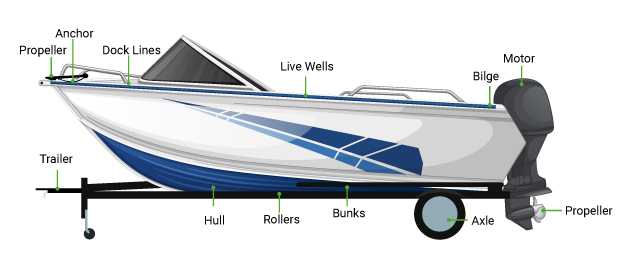
Don’t give mussels the muscle to spread! It is always a good idea to inspect your watercraft, trailers and hauling gear. Ensuring your haul has been cleaned, drained, and dried helps reduce the harm to Canada’s waterbodies. Why not consider making clean, drain, dry protocols a part of your pre-haul checklist?
